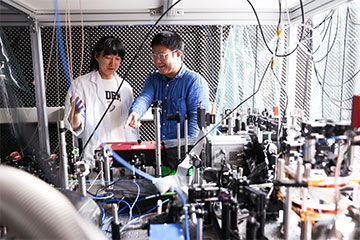
Scientists used two optical traps to throw and catch individual atoms. This is the first time an atom has been released from a trap and then caught by another trap. [Image: J. Ahn, KAIST]
Every child knows the simple joy of tossing a ball. Now physicists can throw and catch single atoms—not with their hands and arms, but with optical tweezers.
Researchers based in the Republic of Korea and Japan performed the feat to demonstrate how flying atoms might someday enable dynamic quantum calculations (Optica, doi: 10.1364/OPTICA.480535). The technique might also prove useful in rearranging atoms within an array.
Guiding versus tossing
Previously, researchers have guided cold neutral atoms into desired paths by using arrays of optical tweezers. However, when these arrays get crowded, it’s easy for atoms to come out of their proper positions. Scientists have envisioned these cold atoms as information carriers within quantum computers, but with atoms traveling from point to point within an array.
Physicist Jaewook Ahn, Korea Advanced Institute of Science and Technology (KAIST), Republic of Korea, and his colleagues wondered whether they could skip the array and simply toss atoms from one optical trap to another. After all, scientists already understand the equation describing the motion of a particle trapped in optical tweezers and can calculate the acceleration needed to push the particle out of the trap and the deceleration needed to capture the particle in a different trap. The laser creating the tweezers would be switched off during the free flight and turned back on to slow the flying particle down. Timing would be crucial.

Research team members Hansub Hwang (left) and Andrew Byun (right) are pictured with the optical setup used to create free-flying atoms. For throwing, a trap holding an atom is accelerated and then turned off, which causes the atom to launch out of the trap. Another trap is then turned on to capture the incoming atom and decelerated until the atom stops completely. [Image: J. Ahn, KAIST]
From theory to experiment
After working out the theoretical basis for the “throwing” and “catching,” the team chilled rubidium-87 atoms down to 40 μK and set up optical tweezers using an 820-nm-wavelength laser. According to Ahn, rubidium-87 is one of the most frequently studied atoms in nanomanipulation, so its properties are relatively predictable.
During the experiments, an acousto-optic modulator and arbitrary waveform generator controlled the dynamic optical tweezers that did the throwing and catching, while a 2D spatial light modulator drove the static optical tweezers used in some of the experimental runs. Each trap was 0.73 μm wide, and the free-flying distance was 4.2 μm, which was all the experimental setup could accommodate.
It took a bit of practice, but Ahn and his team ultimately managed to catch the atom about 87 percent of the time. Although the experiment didn’t go well in the beginning, “To our total surprise, it [eventually] worked relatively easily,” he says. The researchers also experimented with tossing atoms past a static optical trap between two dynamic traps.
Besides fine-tuning the technique to bring their catching success rate closer to 100%, Ahn’s group, which studies quantum computing, plans other experiments. The scientists are now exploring collisions between individual atoms. “We were able to pump a flying atom to a Rydberg atom of a micrometer-size and make it deterministically bump against a stationary, other Rydberg atom,” Ahn says.
